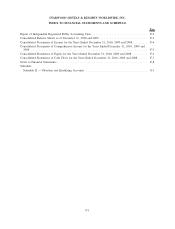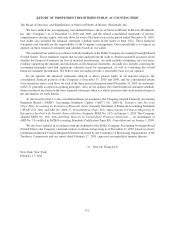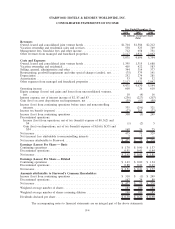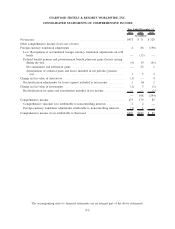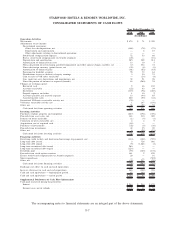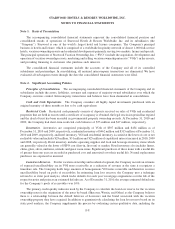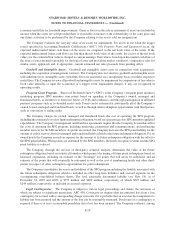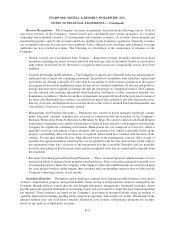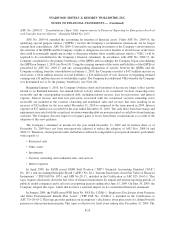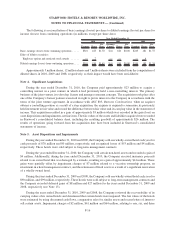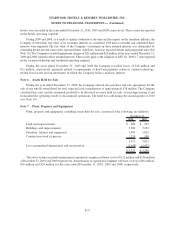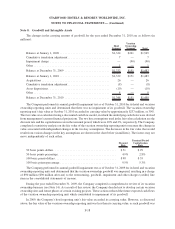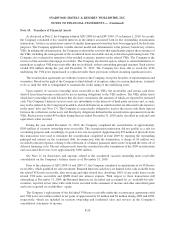Starwood 2010 Annual Report Download - page 126
Download and view the complete annual report
Please find page 126 of the 2010 Starwood annual report below. You can navigate through the pages in the report by either clicking on the pages listed below, or by using the keyword search tool below to find specific information within the annual report.economic useful life for leasehold improvements. Gains or losses on the sale or retirement of assets are included in
income when the assets are sold provided there is reasonable assurance of the collectability of the sales price and
any future activities to be performed by the Company relating to the assets sold are insignificant.
The Company evaluates the carrying value of its assets for impairment. For assets in use when the trigger
events specified in Accounting Standards Codification (“ASC”) 360, Property Plant, and Equipment occur, the
expected undiscounted future cash flows of the assets are compared to the net book value of the assets. If the
expected undiscounted future cash flows are less than the net book value of the assets, the excess of the net book
value over the estimated fair value is charged to current earnings. Fair value is based upon discounted cash flows of
the assets at rates deemed reasonable for the type of asset and prevailing market conditions, comparative sales for
similar assets, appraisals and, if appropriate, current estimated net sales proceeds from pending offers.
Goodwill and Intangible Assets. Goodwill and intangible assets arise in connection with acquisitions,
including the acquisition of management contracts. The Company does not amortize goodwill and intangible assets
with indefinite lives. Intangible assets with finite lives are amortized on a straight-line basis over their respective
useful lives. The Company reviews all goodwill and intangible assets for impairment by comparisons of fair value to
book value annually, or upon the occurrence of a trigger event. Impairment charges, if any, are recognized in
operating results.
Frequent Guest Program. Starwood Preferred Guest»(“SPG”) is the Company’s frequent guest incentive
marketing program. SPG members earn points based on spending at the Company’s owned, managed and
franchised hotels, as incentives to first-time buyers of VOIs and residences, and through participation in affiliated
partners’ programs such as co-branded credit cards. Points can be redeemed at substantially all of the Company’s
owned, leased, managed and franchised hotels as well as through other redemption opportunities with third parties,
such as conversion to airline miles.
The Company charges its owned, managed and franchised hotels the cost of operating the SPG program,
including the estimated cost of its future redemption obligation, based on a percentage of its SPG members qualified
expenditures. The Company’s management and franchise agreements require that the Company be reimbursed for
the costs of operating the SPG program, including marketing, promotions and communications, and performing
member services for the SPG members. As points are earned, the Company increases the SPG point liability for the
amount of cash it receives from its managed and franchised hotels related to the future redemption obligation. For its
owned hotels the Company records an expense for the amount of its future redemption obligation with the offset to
the SPG point liability. When points are redeemed by the SPG members, the hotels recognize revenue and the SPG
point liability is reduced.
The Company, through the services of third-party actuarial analysts, determines the value of the future
redemption obligation based on statistical formulas which project the timing of future point redemptions based on
historical experience, including an estimate of the “breakage” for points that will never be redeemed, and an
estimate of the points that will eventually be redeemed as well as the cost of reimbursing hotels and other third-
parties in respect of other redemption opportunities for point redemptions.
The Company consolidates the assets and liabilities of the SPG program including the liability associated with
the future redemption obligation which is included in other long-term liabilities and accrued expenses in the
accompanying consolidated balance sheets. The total actuarially determined liability (see Note 18), as of
December 31, 2010 and 2009, is $753 million and $689 million, respectively, of which $225 million and
$244 million, respectively, is included in accrued expenses.
Legal Contingencies. The Company is subject to various legal proceedings and claims, the outcomes of
which are subject to significant uncertainty. ASC 450, Contingencies requires that an estimated loss from a loss
contingency be accrued with a corresponding charge to income if it is probable that an asset has been impaired or a
liability has been incurred and the amount of the loss can be reasonably estimated. Disclosure of a contingency is
required if there is at least a reasonable possibility that a loss has been incurred. The Company evaluates, among
F-10
STARWOOD HOTELS & RESORTS WORLDWIDE, INC.
NOTES TO FINANCIAL STATEMENTS — (Continued)



